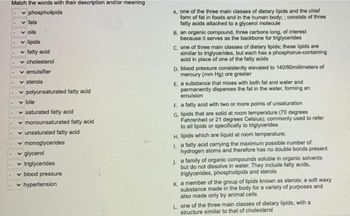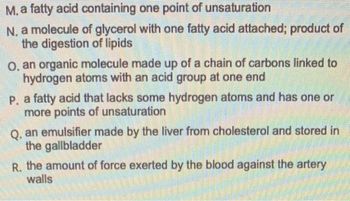
Human Anatomy & Physiology (11th Edition)
11th Edition
ISBN: 9780134580999
Author: Elaine N. Marieb, Katja N. Hoehn
Publisher: PEARSON
expand_more
expand_more
format_list_bulleted
Concept explainers
Question

Transcribed Image Text:Match the words with their description and/or meaning
✓phospholipids
.
fats
voils
✓ lipids
✓ fatty acid
v cholesterol
✓emulsifier
✓sterols
polyunsaturated fatty acid
v bile
saturated fatty acid
✓ monounsaturated fatty acid
✓ unsaturated fatty acid
✓ monoglycerides
✓ glycerol
✓ triglycerides
blood pressure
✓ hypertension
A, one of the three main classes of dietary lipids and the chief
form of fat in foods and in the human body;; consists of three
fatty acids attached to a glycerol molecule
B. an organic compound, three carbons long, of interest
because it serves as the backbone for triglycerides
C. one of three main classes of dietary lipids; these lipids are
similar to triglycerides, but each has a phosphorus-containing
acid in place of one of the fatty acids
D. blood pressure consistently elevated to 140/90millimeters of
mercury (mm Hg) ore greater
E, a substance that mixes with both fat and water and
permanently disperses the fat in the water, forming an
emulsion
F. a fatty acid with two or more points of unsaturation
G. lipids that are solid at room temperature (70 degrees
Fahrenheit or 21 degrees Celsius); commonly used to refer
to all lipids or specifically to triglycerides
H. lipids which are liquid at room temperature;
La fatty acid carrying the maximum possible number of
hydrogen atoms and therefore has no double bonds present
J. a family of organic compounds soluble in organic solvents
but do not dissolve in water. They include fatty acids,
triglycerides, phospholipids and sterols
K a member of the group of lipids known as sterols; a soft waxy
substance made in the body for a variety of purposes and
also made only by animal cells
L. one of the three main classes of dietary lipids, with a
structure similar to that of cholesterol

Transcribed Image Text:M. a fatty acid containing one point of unsaturation
N. a molecule of glycerol with one fatty acid attached; product of
the digestion of lipids
O, an organic molecule made up of a chain of carbons linked to
hydrogen atoms with an acid group at one end
P. a fatty acid that lacks some hydrogen atoms and has one or
more points of unsaturation
Q. an emulsifier made by the liver from cholesterol and stored in
the gallbladder
R. the amount of force exerted by the blood against the artery
walls
Expert Solution
This question has been solved!
Explore an expertly crafted, step-by-step solution for a thorough understanding of key concepts.
This is a popular solution
Trending nowThis is a popular solution!
Step by stepSolved in 3 steps

Knowledge Booster
Learn more about
Need a deep-dive on the concept behind this application? Look no further. Learn more about this topic, biology and related others by exploring similar questions and additional content below.Similar questions
- Match the description with the correct fatty acid. D These have some double bonds Triglycerides with these are liquid at room temperature. Triglycerides with these are solid at room temperature. These only have single bonds. 1. Saturated fatty acid 2. Unsaturated fatty acidarrow_forward5. How would the following fatty acid be characterized? HO A. short chain, saturated B. medium chain, saturated C. long chain, saturated D. short chain, unsaturated E. medium chain, unsaturated F. long chain, unsaturatedarrow_forward21. Saponification involves. A. the acidic hydrolysis of a glycerophospholipid B. the basic hydrolysis of a glycerophospholipid C. the acidic hydrolysis of a triacylglycerol D. the basic hydrolysis of a triacylglycerol E. None of the above.arrow_forward
- 14. What type of lipid contains two fatty acids in its structure? A. Wax B. Sphingolipid C. Steroid D. Glycerophospholipid E. Triglyceridearrow_forward2. Identify whether the following fatty acids are saturated or unsaturated. a. CH3(CH2)5CH=CH(CH2)7COOH b. CH3(CH2)7CH-CH(CH₂)7COOH C. CH3(CH2) 10COOH d. CH3(CH2) 16COOH e. CH3CH2(CH=CHCH2) 3(CH2)6COOHarrow_forward1. What is the chemical formula for palmitic acid and oleic acid? Which one is a saturated fat and which one is an unsaturated fat? How do you know? 2. What functional groups are involved in dehydration synthesis reactions to form a triglyceride? What is the waste product? 3. Compare the overall acidity of the molecules before and after the formation of a triglyceride. Proteins 1. What gives each amino R group its key characteristics to make it polar, non-polar, or ionic? 2. What functional groups are involved in dehydration synthesis? 3. How might the solubility of peptides be influenced by the size of the peptides? How might the R group of the amino acid influence it? 4. Would you consider the formation of a peptide bond to be an example of a neutralization reaction? Explain your reasoning.arrow_forward
- The following triacylglycerols (Tag) contain different percentages of unsaturated fatty acids. What would be the order of melting points going from highest to lowest? Tag 1: 25% Tag 2: 50% Tag 3: 75% a. highest 2-3-1 lowest b. highest 3-2-1 lowest c. the melting points are all the same d. highest 1-2-3 lowestarrow_forwardD. C3H,O3 4. Which of the following formulae of fatty acids represents saturated fatty acid? (i) Palmitic acid, C15H3,COOH (ii) Oleic acid, C ,H3,COOH (iii) Linoleic acid, C17H3 COOH A. (i), (ii) and (ii) B. Only (i) and (ii) C. Only (ii) and (ii) D. Only (i)arrow_forward
arrow_back_ios
arrow_forward_ios
Recommended textbooks for you
 Human Anatomy & Physiology (11th Edition)BiologyISBN:9780134580999Author:Elaine N. Marieb, Katja N. HoehnPublisher:PEARSON
Human Anatomy & Physiology (11th Edition)BiologyISBN:9780134580999Author:Elaine N. Marieb, Katja N. HoehnPublisher:PEARSON Biology 2eBiologyISBN:9781947172517Author:Matthew Douglas, Jung Choi, Mary Ann ClarkPublisher:OpenStax
Biology 2eBiologyISBN:9781947172517Author:Matthew Douglas, Jung Choi, Mary Ann ClarkPublisher:OpenStax Anatomy & PhysiologyBiologyISBN:9781259398629Author:McKinley, Michael P., O'loughlin, Valerie Dean, Bidle, Theresa StouterPublisher:Mcgraw Hill Education,
Anatomy & PhysiologyBiologyISBN:9781259398629Author:McKinley, Michael P., O'loughlin, Valerie Dean, Bidle, Theresa StouterPublisher:Mcgraw Hill Education, Molecular Biology of the Cell (Sixth Edition)BiologyISBN:9780815344322Author:Bruce Alberts, Alexander D. Johnson, Julian Lewis, David Morgan, Martin Raff, Keith Roberts, Peter WalterPublisher:W. W. Norton & Company
Molecular Biology of the Cell (Sixth Edition)BiologyISBN:9780815344322Author:Bruce Alberts, Alexander D. Johnson, Julian Lewis, David Morgan, Martin Raff, Keith Roberts, Peter WalterPublisher:W. W. Norton & Company Laboratory Manual For Human Anatomy & PhysiologyBiologyISBN:9781260159363Author:Martin, Terry R., Prentice-craver, CynthiaPublisher:McGraw-Hill Publishing Co.
Laboratory Manual For Human Anatomy & PhysiologyBiologyISBN:9781260159363Author:Martin, Terry R., Prentice-craver, CynthiaPublisher:McGraw-Hill Publishing Co. Inquiry Into Life (16th Edition)BiologyISBN:9781260231700Author:Sylvia S. Mader, Michael WindelspechtPublisher:McGraw Hill Education
Inquiry Into Life (16th Edition)BiologyISBN:9781260231700Author:Sylvia S. Mader, Michael WindelspechtPublisher:McGraw Hill Education

Human Anatomy & Physiology (11th Edition)
Biology
ISBN:9780134580999
Author:Elaine N. Marieb, Katja N. Hoehn
Publisher:PEARSON

Biology 2e
Biology
ISBN:9781947172517
Author:Matthew Douglas, Jung Choi, Mary Ann Clark
Publisher:OpenStax

Anatomy & Physiology
Biology
ISBN:9781259398629
Author:McKinley, Michael P., O'loughlin, Valerie Dean, Bidle, Theresa Stouter
Publisher:Mcgraw Hill Education,

Molecular Biology of the Cell (Sixth Edition)
Biology
ISBN:9780815344322
Author:Bruce Alberts, Alexander D. Johnson, Julian Lewis, David Morgan, Martin Raff, Keith Roberts, Peter Walter
Publisher:W. W. Norton & Company

Laboratory Manual For Human Anatomy & Physiology
Biology
ISBN:9781260159363
Author:Martin, Terry R., Prentice-craver, Cynthia
Publisher:McGraw-Hill Publishing Co.

Inquiry Into Life (16th Edition)
Biology
ISBN:9781260231700
Author:Sylvia S. Mader, Michael Windelspecht
Publisher:McGraw Hill Education